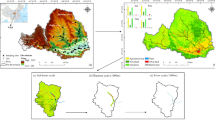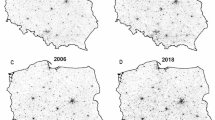Abstract
This study mainly explores the best relationship between hydrograph parameters and urbanized factors in urbanized areas. Urbanization of a developing watershed is analyzed through 51 available rainfall-runoff simulations from 1966 to 2002. Forty of these rainfall-runoff events were calibrated to determine the relationships between impervious area and urbanized factors. During the calibration process, the block Kriging method was used to estimate the mean rainfall, and its hourly excesses were calculated by nonlinear programming. Then, clear tendencies between parameters and urbanized factors were produced by comparing the results of the annual average and optimal interval methods. The remaining eleven cases were used to verify the established relationships. The calibration and verification results confirm that the integral approaches used in this study can effectively illustrate the hydrological and geomorphic conditions in complex urbanized processes. Parameter n responds more sensitively than parameter k to increasing impervious area and population density. Additionally, parameter n responds more strongly to imperviousness than to population. Therefore, this study demonstrates that an impervious area is the main consequence of ongoing urbanization in the Wu-Tu watershed. The satisfactory results show that kernel response of the watershed would be more sharp-pointed and be shifted forward in peak due to an increased impervious cover.





Similar content being viewed by others
References
Arnold CLJ, Gibbons CJ (1996) Impervious surface coverage—the emergence of a key environmental indicator. J Am Plan As 62:243–256
Bastin G, Lorent B, Duque C, Gevers M (1984) Optimal estimation of the average rainfall and optimal selection of raingauge locations. Water Resour Res 20:463–470
Boyd MJ, Bufill MC, Knee RM (1994) Predicting pervious and impervious storm runoff from urban basins. Hydrol Sci J 39:321–332
Brown RG (1988) Effects of precipitation and land use on storm runoff. Water Resour Bull 24:421–426
Cheng SJ (2010) Raingauge significance evaluation based on mean hyetographs. Nat Hazards. doi:10.1007/s11069-010-9589-3
Cheng SJ, Wang RY (2002) An approach for evaluating the hydrological effects of urbanization and its application. Hydrol Process 16:1403–1418
Cheng SJ, Hsieh HH, Wang YM (2007) Geostatistical interpolation of space-time rainfall on Tamshui River Basin, Taiwan. Hydrol Process 21:3136–3145
Cheng SJ, Hsieh HH, Lee CF, Wang YM (2008) The storage potential of different surface coverings for various scale storms on Wu-Tu watershed, Taiwan. Nat Hazards 44:129–146
Cheng SJ, Lee CF, Lee JH (2010) Effects of urbanization factors on model parameters. Water Resour Manag 24:775–794
Chow VT, Maidment DR, Mays LW (1988) Applied hydrology. McGraw-Hill Book Company, New York
Duan Q, Gupta VK, Sorooshian S (1993) Shuffled complex evolution approach for effective and efficient global minimization. J Optim Theor Appl 76:501–521
Ferguson BK, Suckling PW (1990) Changing rainfall-runoff relationships in the urbanizing Peachtree Creek Watershed, Atlanta, Georgia. Water Resour Bull 26:313–322
Franchini M, O’Connell PE (1996) An analysis of the dynamic component of the geomorphologic instantaneous unit hydrograph. J Hydrol 175:407–428
Gremillion P, Gonyeau A, Wanielista M (2000) Application of alternative hydrograph separation models to detect changes in flow paths in a watershed undergoing urban development. Hydrol Process 14:1485–1501
Hannah DM, Gurnell AM (2001) A conceptual, linear reservoir runoff model to investigate melt season changes in cirque glacier hydrology. J Hydrol 246:123–141
Hollis GE (1975) The effect of urbanization on floods of different recurrence interval. Water Resour Res 11:431–435
Hsieh LS, Wang RY (1999) A semi-distributed parallel-type linear reservoir rainfall-runoff model and its application in Taiwan. Hydrol Process 13:1247–1268
Huang HJ, Cheng SJ, Wen JC, Lee JH (2008a) Effect of growing watershed imperviousness on hydrograph parameters and peak discharge. Hydrol Process 22:2075–2085
Huang SY, Cheng SJ, Wen JC, Lee JH (2008b) Identifying peak-imperviousness-recurrence relationships on a growing-impervious watershed, Taiwan. J Hydrol 362:320–336
Junil P, Kang IS, Singh VP (1999) Comparison of simple runoff models used in Korea for small watersheds. Hydrol Process 13:1527–1540
Kang IS, Park JI, Singh VP (1998) Effect of urbanization on runoff characteristics of the On-Cheon Stream Watershed in Pusan, Korea. Hydrol Process 12:351–363
Lee YH, Singh VP (2005) Tank model for sediment yield. Water Resour Manag 19:349–362
Leopold LB (1991) Lag times for small drainage basins. Catena 18:157–171
Matheussen B, Kirschbaum RL, Goodman IA, O’Donnell GM (2000) Effects of land cover changes on streamflow in the Interior Columbia River Basin (USA and Canada). Hydrol Process 14:867–885
Moon J, Kim JH, Yoo C (2004) Storm-coverage effect on dynamic flood-frequency analysis: empirical data analysis. Hydrol Process 18:159–178
Moscrip AL, Montgomery DR (1997) Urbanization, flood frequency, and salmon abundance in Puget Lowland Streams. J Am Water Resour As 33:1289–1297
Nash JE (1957) The form of the instantaneous unit hydrograph, vol 45. IAHS Publications, pp 112–121
Sala M, Inbar M (1992) Some hydrologic effects of urbanization in Catalan Rivers. Catena 19:363–378
Simmons DL, Reynolds RJ (1982) Effects of urbanization on base flow of selected south-shore streams, Long Island, New York. Water Resour Bull 18:797–805
Singh RB (1998) Land use/cover changes, extreme events and ecohydrological response in the Himalayan Region. Hydrol Process 12:2043–2055
White LW, Vieux B, Armand D (2002) Surface flow model: inverse problems and predictions. Adv Water Resour 25:317–324
Yue S, Hashino M (2000) Unit hydrographs to model quick and slow runoff components of streamflow. J Hydrol 227:195–206
Author information
Authors and Affiliations
Corresponding author
Rights and permissions
About this article
Cite this article
Cheng, Sj. The best relationship between lumped hydrograph parameters and urbanized factors. Nat Hazards 56, 853–867 (2011). https://doi.org/10.1007/s11069-010-9596-4
Received:
Accepted:
Published:
Issue Date:
DOI: https://doi.org/10.1007/s11069-010-9596-4




